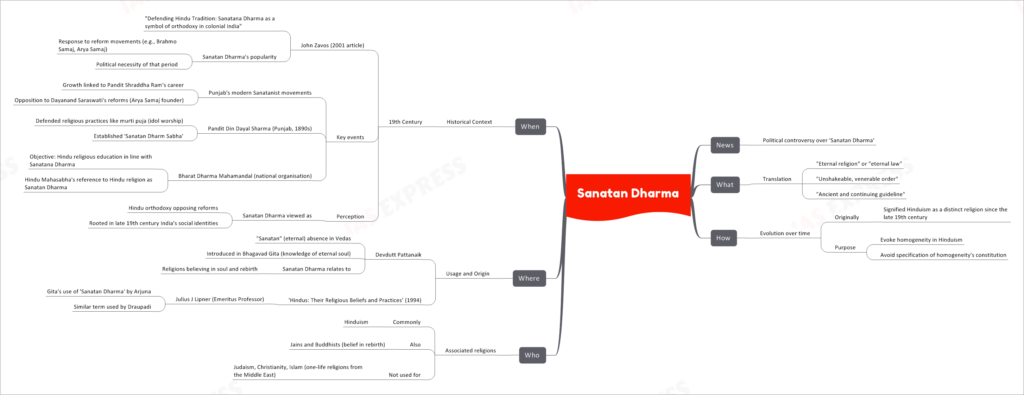Sanatan Dharma

In recent news, the term “Sanatan Dharma” has been at the center of a political controversy, raising questions about its significance and implications.
This topic of “Sanatan Dharma” is important from the perspective of the UPSC IAS Examination, which falls under General Studies Portion.
What is Sanatan Dharma?
Translation
- “Eternal Religion” or “Eternal Law”: Sanatan Dharma can be translated to mean the “eternal religion” or “eternal law,” emphasizing its timeless nature.
- “Unshakeable, Venerable Order”: It also conveys the idea of an “unshakeable, venerable order” that transcends time and space.
- “Ancient and Continuing Guideline”: Another translation highlights it as an “ancient and continuing guideline,” suggesting its enduring relevance.
How has Sanatan Dharma Evolved Over Time?
Originally
- Sanatan Dharma originally signified Hinduism as a distinct religion since the late 19th century.
- Its purpose was to evoke homogeneity in Hinduism and avoid specifying the constitution of that homogeneity.
Who is Associated with Sanatan Dharma?
Commonly
- Commonly associated with Hinduism, Sanatan Dharma has deep roots in the Hindu faith.
- It also extends its influence to Jains and Buddhists, primarily due to their shared belief in rebirth.
- However, it is not used to describe one-life religions from the Middle East, such as Judaism, Christianity, and Islam.
Where Did Sanatan Dharma Find Its Usage and Origin?
- Devdutt Pattanaik, a renowned scholar, notes that the term “Sanatan” (eternal) is absent in the Vedas but was introduced in the Bhagavad Gita, emphasizing the knowledge of the eternal soul.
- Sanatan Dharma relates to religions that believe in the soul’s eternity and the concept of rebirth.
- In ‘Hindus: Their Religious Beliefs and Practices’ (1994), Julius J Lipner, an Emeritus Professor, points to the Gita’s use of ‘Sanatan Dharma’ by Arjuna, and a similar term is used by Draupadi.
When Did Sanatan Dharma Gain Historical Significance?
19th Century
- In the 19th century, Sanatan Dharma gained prominence in response to reform movements like the Brahmo Samaj and Arya Samaj.
- John Zavos, in his 2001 article, highlights its role as a symbol of orthodoxy in colonial India, emphasizing its popularity during this period.
- Key events include the growth of Punjab’s modern Sanatanist movements, linked to Pandit Shraddha Ram’s career and their opposition to Dayanand Saraswati’s reforms, the founder of Arya Samaj.
- Pandit Din Dayal Sharma in Punjab during the 1890s defended religious practices like murti puja (idol worship) and established the ‘Sanatan Dharm Sabha.’
- The Bharat Dharma Mahamandal was formed with the objective of promoting Hindu religious education in line with Sanatana Dharma principles, and the Hindu Mahasabha referred to Hindu religion as Sanatan Dharma during this time.
How is Sanatan Dharma Perceived?
- Sanatan Dharma is often viewed as representing Hindu orthodoxy, opposing the reforms advocated by various movements.
- It is rooted in the social identities of late 19th-century India and served as a response to the political necessities of that period.

